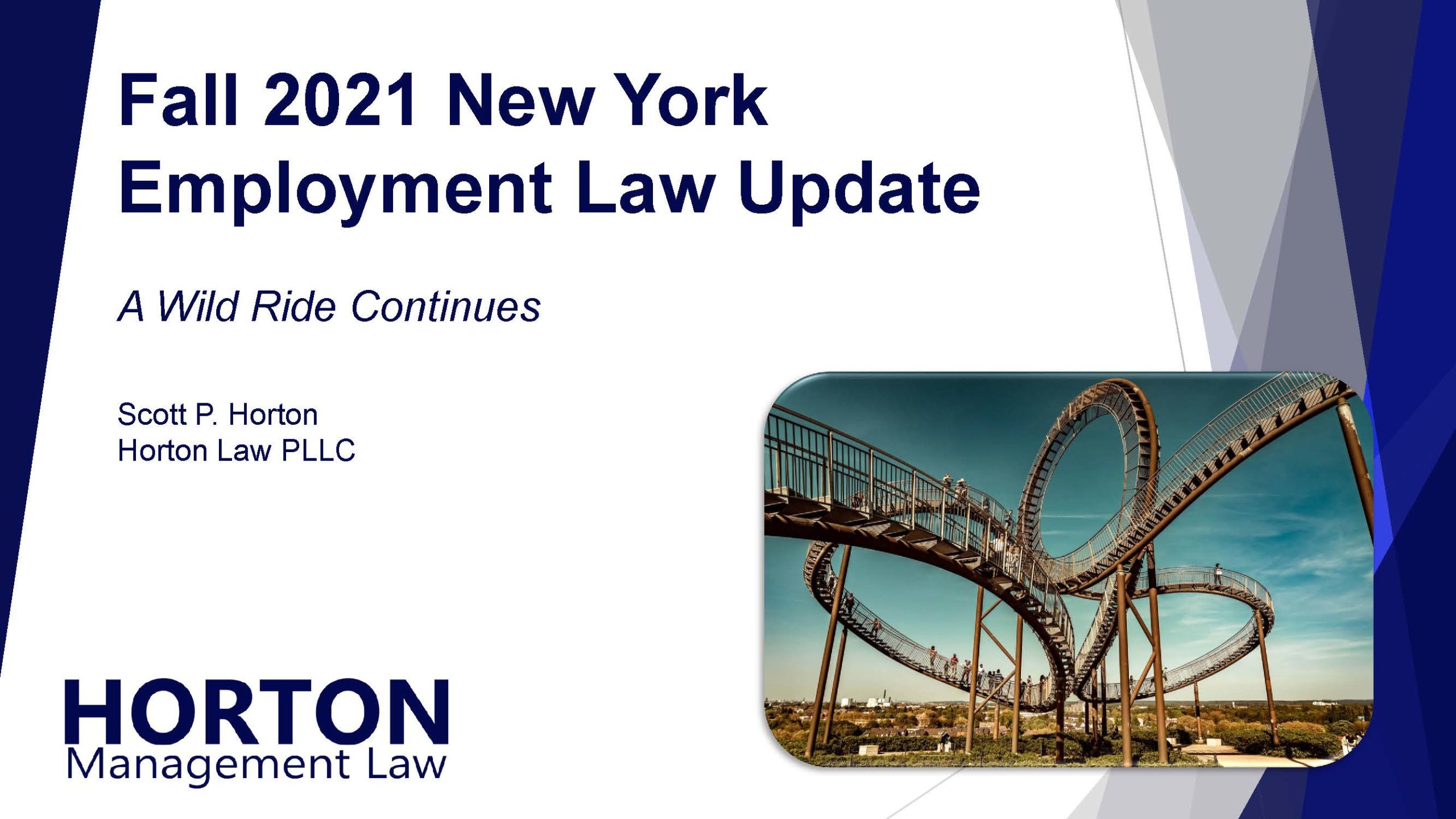The New York HERO Act included provisions enabling workers to form workplace safety committees at their jobs. Those provisions had a November 1, 2021 effective date, and the NYS Department of Labor had promised additional guidance by then. Finally, on December 22, 2021, the DOL issued proposed workplace safety committee rules. Where does this leave employers faced with complying with the HERO Act’s workplace safety committee requirements?
Procedural Status & Impact
As “proposed” rules, the DOL’s latest word on workplace safety committees initially has no formal legal impact. The DOL is scheduled to hold a hearing on the proposed workplace safety committee rules on February 9, 2022. Interested parties may submit written comments on the proposed rules through February 14, 2022. At some point after that date, the DOL may finalize rules regarding the HERO Act‘s workplace safety committee requirements.
Until the DOL publishes final rules, employers face a compliance dilemma. The statutory workplace safety committee provisions have been, at least arguably, in effect since November. Some employers have undoubtedly attempted to comply with the law before these proposed regulations were available. Many of the resultant workplace safety committees may not satisfy the parameters of the proposed regulations, which were not wholly predictable from the statutory language.
There may be a reasonable debate whether employers are legally subject to the workplace safety committee portion of the HERO Act before the DOL finalizes its regulations. Indeed, the statute states that “The commissioner [of labor] shall adopt and amend rules and regulations to effectuate the provisions and purposes of this section.” Until such regulations have been adopted, has the law been effectuated?
Establishment of Workplace Safety Committees
When
Since the HERO Act became law, there has been uncertainty whether all covered employers (private employers with 10+ employees in NYS) must form a workplace safety committee. The DOL’s proposed rules indicate that employers need only recognize a workplace safety committee after at least two employees have requested one in writing.
Upon receiving such requests, employers must respond “with reasonable promptness.”
Interestingly, after one workplace safety committee has been formed at a worksite, the proposed rules provide that the employer must deny subsequent requests and refer them to the existing workplace safety committee.
Where
The HERO Act limits workplace safety committees to one per “worksite.” The proposed workplace safety committee rules address the meaning of “worksite” at length.
Worksites may be a single location or multiple that are in close proximity. However, separate buildings or facilities not close enough together or run distinctly may be considered different worksites. Despite some bright lines, the proposed rule seemingly leaves enough room for ambiguity to frustrate many employers.
The worksite of employees who travel, telecommute, etc., is “the worksite to which they are assigned as their employer’s home base, from which their work is assigned, or to which they report.”
Notably, workers at worksites with less than 10 employees could still form workplace safety committees if the employer has at least 10 employees statewide.
The proposed rules make an exception for “temporary worksites,” where no employee works for less than 20 days. The employer need not recognize a workplace safety committee at such a location.
Who
The law requires that at least two-thirds of the committee’s members be “non-supervisory employees.” The proposed rules define “non-supervisory employees” as those who do not “perform supervisory responsibilities, which includes but is not limited to the authority to direct and/or control the work performance of other employees.” Curiously, the rules further state that non-supervisory employees exclude “managerial and executive employees” without defining those categories.
The DOL proposes a cap on the number of members of a workplace safety committee. Any committee is limited to the lower of 12 members or one-third of the total number of employees at the worksite. The minimum number is three members.
Following the statutory language, the proposed rules state:
At a worksite where there is a collective bargaining agreement in place, the collective bargaining representative shall select the employee representatives, who may be any non-supervisory employee covered by the collective bargaining agreement.
On the other hand:
Non-supervisory employees at a worksite without a collective bargaining agreement in place shall be selected by and amongst the employer’s non-supervisory employees as determined by the non-supervisory employees of the employer.
The DOL provides examples of possible selection methods, including “self-selection,” “nomination by co-workers,” and “elections.”
Surprisingly, the rules don’t specifically address who determines how many non-supervisory employees will be on the committee or who selects them. It only states that the employer must appoint a representative to serve as co-chair. But this employer representative may be “a non-supervisory employee, an officer, the employer, or other representative.” And, according to the proposed rules, “No non-supervisory employee may be a member of two different workplace safety committees for the same employer.”
Committee Activities
The HERO Act provides an assortment of functions for workplace safety committees to serve. The proposed rules offer some effort to clarify them.
The rules go so far as to suggest a workplace safety committee may “establish rules or bylaws,” which “may include but are not limited to procedures for the selection of new members, terms of members, and the training of new members.” However, the DOL cautions that any bylaws that exceed or conflict with the HERO Act’s grant of responsibilities would be ineffectual.
Failing alternative adopted rules or procedures, the proposed regulations provide that committee actions would be taken only by majority vote.
The rules reiterate statutory provisions regarding paid meeting and training time. The employer must pay committee members for participating in meetings of up to two hours per quarter and training of up to 4 hours per year. The DOL suggests committee members can meet or otherwise work on committee matters for more than two hours per quarter outside of work hours and without pay, unless the employer agrees to provide payment.
Employer Obligations
Although the proposed workplace safety committee rules don’t specifically address the committees’ statutory rights to review workplace safety and health policies, they do provide that employers must respond to requests for such policies “within a reasonable amount of time.”
Employers must similarly “respond, in writing, to each safety and health concern, hazard, complaint and other violations raised by the workplace safety committee or one of its members within a reasonable time period.”
Companies must also notify, in advance, their workplace safety committee of any visits by an outside government official enforcing safety and health standards.
What Should New York Employers Do Now?
The best news about the proposed workplace safety committee rules is that they don’t suggest employers must do anything before receiving written requests from at least two employees about the creation of a committee. However, the big questions come if you receive such requests.
Private employers with at least 10 employees in New York are arguably required to allow employees to form a workplace safety committee now. But the path to doing so is fraught.
Employers could attempt, where feasible, to follow the proposed rules. However, it seems highly unlikely that the proposed rules will be adopted in precisely their current form. There are simply too many holes in the regulations for them to stand as proposed. Frankly, one wonders if the DOL even intends, as it often does, that its proposed rules will become the final rules. Perhaps, they just finally issued something to get the process started in the face of a direct legislative mandate that they were already tardy in satisfying.
But employers who wish to ignore the proposed rules in favor of the statutory text will find that lacking in relevant respects. Even the Legislature knew that the HERO Act alone wouldn’t provide a workable framework for creating workplace safety committees. They affirmatively passed that responsibility to the DOL. Which begs a question. . . .
Is the Workplace Safety Committee Component of the HERO Act Legally Enforceable?
I have serious doubts. The statute itself is likely too vague to enforce. Can that be saved by “clarifying” DOL regulations? Perhaps. But is it possible for the DOL to issue regulations that are both consistent with the statutory language and not inconsistent with other legal principles?
The references to worksites with collective bargaining agreements in place seem particularly problematic. Here, the Legislature missed the mark in critical respects. First, it totally ignored the reality that many worksites have multiple bargaining units, potentially with separate unions representing them and/or with multiple collective bargaining agreements. Then there’s the matter of unrepresented non-supervisory employees at worksites with bargaining units. The law and the proposed rules seem to grant the bargaining representative the right to dictate whether such unrepresented employees have any participation in the workplace safety committees. Plus, the law peculiarly relies on the existence of a collective bargaining agreement. But what if the agreement has expired or a representative has been selected, but not yet negotiated a first contract? Does the bargaining representative have no role in determining the workplace safety committee members? Since private-sector collective bargaining is primarily regulated by federal labor laws, is there a preemption question?
Time will tell, but I would be surprised if we don’t see serious challenges to the HERO Act’s whole workplace safety committee scheme. In the meantime, employers facing the formation of workplace safety committees are strongly encouraged to consult with experienced labor and employment counsel.
For future updates regarding this and other important topics for New York employers, sign up for the Horton Law email newsletter and follow us on LinkedIn.


